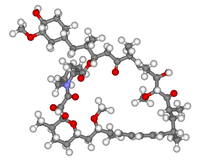
Photo from wikipedia
Kinases remain one of the major attractive therapeutic targets for a large number of indications such as cancer, rheumatoid arthritis, cardiac failure and many others. Design and development of kinase… Click to show full abstract
Kinases remain one of the major attractive therapeutic targets for a large number of indications such as cancer, rheumatoid arthritis, cardiac failure and many others. Design and development of kinase inhibitors (ATP-competitive, allosteric or covalent) is a clinically validated and successful strategy in the pharmaceutical industry. . The perks come with limitations, particularly development of resistance to highly potent and selective inhibitors. That's when the cycle needs to be repeated, i.e., design and development of kinase inhibitors active against the mutated forms. The complexity of tumor milieu makes it awfully difficult for these molecularly-targeted therapies to work. Every year newer and better versions of these agents are introduced in the clinic. Several computational approaches such as structure-, ligand-based or hybrid ones continue to live up to their potential in discovering novel kinase inhibitors. Newer throught processes in this area continue to emerge, e.g., development of dual-target kinase inhibitors. But there are fundamental issues with this approach. It is indeed difficult to selectively optimize binding at two entirely different or related kinases. In addition to the conventional strategies, the modern technologies (machine learning, deep learning, artificial intelligence, etc.) started yielding the results and building success stories. Computational tools invariably played a critical role in catalysing the phenomenal progress in kinase drug discovery field. The present review summarized the progress in utilizing computational methods and tools for discovering (mutant-)selective tyrosine kinase inhibitor drugs in the last three years (2017-2019). Representative investigations are discussed briefly while others are merely listed.. The authors believe that the enthusiastic reader will be inspired to dig out the cited literature extensively to appreciate the progress made so far and the future prospects of the field.
Journal Title: Current topics in medicinal chemistry
Year Published: 2020
Link to full text (if available)
Share on Social Media: Sign Up to like & get
recommendations!